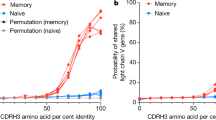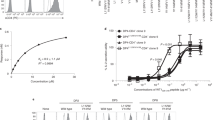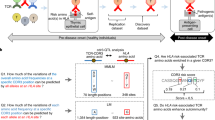Abstract
The major histocompatibility complex (MHC) is a genetic region originally defined by graft rejection and now known to encode at least three classes of molecules which have important roles in the immune system. The MHC class I and class II antigens are both polymorphic two-chain cell-surface glycoproteins which are recognized by T lymphocytes. However, they are generally recognized by different subsets of T cells and have different functions, different tissue distributions and, by all available evidence, different structures1–4. Much is known about the detailed structure of the class I antigens (HLA-A, B, C in human; H–2K,D,L in mouse)5–7. The 44,000 (44K)-molecular weight (Mr) heavy chain consists of an amino-terminal extracellular region composed of three 10KMr (90 amino acid) domains, a small hydrophobic membraneous segment and a small hydrophilic intracellular carboxy-terminal domain. The two amino-terminal domains are polymorphic, bear the carbohydrate and have no sequence homology with immunoglobulin. The third domain, closest to the membrane, and the 11.6K light chain (β2-microglobulin) are highly conserved and have strong sequence homology with immunoglobulin. The structure of class II antigens (DR, DC1 in human; I–A, I–E in mouse) is much less well understood. Previous experiments involving papain proteolysis of native DR antigen have shown that both the light and heavy chains have a large glycosylated amino-terminal extracellular region, a small hydrophobic membranous region and a small carboxy-terminal hydrophilic region8. We have now applied limited proteolysis to demonstrate that the extracellular region of the light chain consists of two domains, each with a disulphide loop. The amino-terminal domain bears the carbohydrate and is polymorphic, while the carboxy-terminal domain is relatively conserved and has significant amino acid sequence homology with immunoglobulin. These results suggest a new picture of class II antigens indicating strong structural similarities to both class I antigens and immunoglobulins.
This is a preview of subscription content, access via your institution
Access options
Subscribe to this journal
Receive 51 print issues and online access
$199.00 per year
only $3.90 per issue
Buy this article
- Purchase on Springer Link
- Instant access to full article PDF
Prices may be subject to local taxes which are calculated during checkout
Similar content being viewed by others
References
Klein, J. The Biology of the Mouse Histocompatibility 2 Complex (Springer, New York, 1975).
Bodmer W. F., Batchelor, J. R., Bodmer,J. G., Festenstein, H. & Morris, P. J. (eds) Histocompatibility Testing 1977 (Munksgaard, Copenhagen, 1978).
Klein, J. Science 203, 516–521 (1979).
Dorf, M. E. (ed.) The Role of the Major Histocompatibility Complex in Immunobiology (Garland, New York, 1981).
Strominger, J. L. et al. in The Role of the Major Histocompatibility Complex in Immunobiology (ed. Dorf, M. E.) 115–172 (Garland, New York, 1981).
Ploegh, H. T., Orr, H. T. & Strominger, J. L. Cell 24, 287–299 (1981).
Coligan, J. E., Kindt, T. J., Uehara, H., Matrinko, J. & Nathenson, S. G. Nature 291, 35–39 (1981).
Kaufman, J. F. & Strominger, J. L. Proc. natn. Acad. Sci. U.S.A. 76, 6304–6308 (1979).
Kaufman, J. F. & Strominger, J. L. J. Immun. (submitted).
Shackelford, D. A. & Strominger, J. L. J. biol. Chem. (submitted).
Korman, A. J., Ploegh, H. L., Kaufman, J. F., Owen, M. J. & Strominger, J. L. J. exp. Med. 152, 65s–82s (1980).
Springer, T. A., Kaufman, J. F., Terhorst, C. & Strominger, J. L. Nature 268, 213–218 (1977).
Beale, D. & Feinstein, A. Q. Rev. Biophys. 9, 135–180 (1976).
Anzel, L. M. & Poljak, R. J. A. Rev. Biochem. 48, 961–997 (1979).
Shackelford, D. A. & Strominger, J. L. J. exp. Med. 151, 144–165 (1980).
Kaufman, J. F., Andersen, R. L. & Strominger, J. L. J. exp. Med. 152, 37s–53s (1980).
Gates, F. T., Coligan, J. E. & Kindt, T. J. Proc. natn. Acad. Sci. U.S.A. 78, 554–558 (1981).
Humphreys, R. E. et al. J. exp. Med. 144, 98–112 (1976).
Kessler, S. W. J. Immun. 115, 1617–1624 (1975).
Laemmli, U. K. Nature 227, 680–685 (1970).
Bonner, W. M. & Laskey, R. A. Eur. J. Biochem. 46, 83–88 (1974).
Barnstable, C. J. et al. Cell 14, 9–20 (1978).
Brauer, A. W., Margolis, M. N. & Haber, E. Biochemistry 14, 3029–3035 (1975).
Edelman, G. M. et al. Proc. natn. Acad. Sci. U.S.A. 63, 78–85 (1969).
Peterson, P. A., Cunningham, B. A., Berggard, I. & Edelman, G. M. Proc. natn. Acad. Sci. U.S.A. 69, 1697–1701 (1972).
Orr, H. T. Lopez de Castro, J. A., Lancet, D. & Strominger, J. L. Biochemistry 18, 5711–5720 (1979).
Allison, J. P. et al. Proc. natn. Acad. Sci. U.S.A. 75, 3953–3956 (1978).
Kratzin et al. Hoppe-Seylers Z. physiol. Chem. 362, 1665–1669 (1981).
Author information
Authors and Affiliations
Rights and permissions
About this article
Cite this article
Kaufman, J., Strominger, J. HLA-DR light chain has a polymorphic N-terminal region and a conserved immunoglobulin-like C-terminal region. Nature 297, 694–697 (1982). https://doi.org/10.1038/297694a0
Received:
Accepted:
Issue Date:
DOI: https://doi.org/10.1038/297694a0
This article is cited by
-
Which came first, MHC class I or class II?
Immunogenetics (1991)
-
Structural comparison of the genes of two HLA-DR supertypic groups: The loci encoding DRw52 and DRw53 are not truly allelic
Immunogenetics (1987)
-
Polymorphism of human Ia antigens: gene conversion between two DR β loci results in a new HLA-D/DR specificity
Nature (1986)
-
An isolated β 1 exon next to the DR α gene in the HLA-D region
Immunogenetics (1986)
-
DNA sequence analysis of a rat RT1 class 11 A ? gene
Immunogenetics (1985)
Comments
By submitting a comment you agree to abide by our Terms and Community Guidelines. If you find something abusive or that does not comply with our terms or guidelines please flag it as inappropriate.



